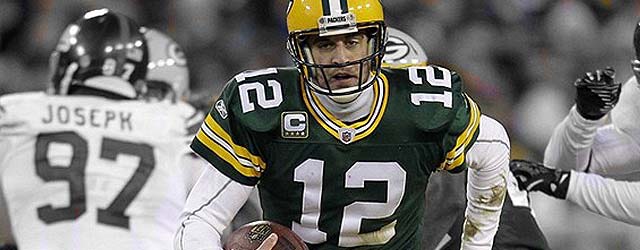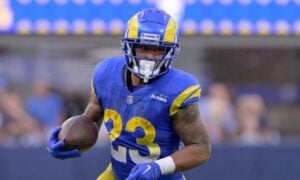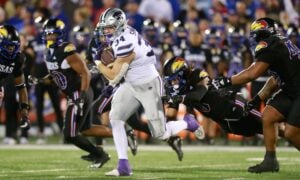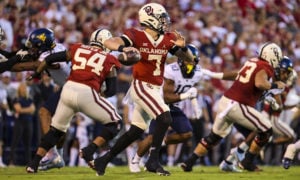Gaming Your Initial Draft

A quick glance around the message boards of many of the top fantasy football sites (including, of course, DLF’s) shows that it’s that time of the year again – time for scores of new leagues to crop up, each with their own initial drafts. Many of you, like me, will join some of these leagues and be part of those. Like every owner involved, you want to get an advantage over your league mates and build the strongest, most dynamic team possible. We’ve all got little tricks to try and squeeze as much of an advantage out of initial drafts as possible. Some work, some don’t. I’d like to use this article to share the tricks I use, methods I’ve heard others have used and would also like to read in the comments what everyone reading does in order to gain that elusive initial advantage.
First, as many of you know, a dynasty draft is a far different beast than drafts which occur in re-draft leagues and must be treated as such. The decisions you make during the draft hold long lasting benefits or consequences for your franchise. While not a trick per se, an owner needs to go into a draft with a much different mindset than in a re-draft league. In re-draft leagues, you’re looking for players who will produce in that season and could care less if a player needs development time. In a redraft league, if a player is still developing, it’s pretty simple – you don’t draft that player. In a dynasty league, however, a developing player is an opportunity for a future star. Therefore, it’s extremely important that when preparing for a dynasty draft you don’t place all your faith in ADP (Average Draft Position) projections unless they specifically say they are intended for dynasty use.
Furthermore, even if an ADP projection list is intended for dynasty use, then one must also confirm it’s intended for the format you’ll be drafting in. An ADP projection list for an IDP league will be very different than one intended for a team defense league. While these lists can be helpful, I must also warn against relying on these lists exclusively. Use them only as a guide, part of your evaluation strategy or as a tie-breaker when you are having a hard time deciding which player to choose. While all of this may seem obvious, I can’t tell you how many times I’ve had people point to ADP lists that don’t fit the format they are playing in or use lists as gospel when selecting their team. Worse yet is when they combine these two unfortunate mistakes.
Now then, with some basics out of the way, let’s get to the good stuff.
How would you like to be picking your players several rounds ahead of your competition? I know I do, who wouldn’t? This tactic requires an active trader, but if done correctly, you could be finishing your draft several rounds before your competition. I almost hesitate to share this tactic because I’ve used it against my fellow DLF staff in leagues we share. While I’m not so bold as to claim I’m the only one using this tactic, I don’t see this tactic used very widely and it’s very sneaky.
First, let your league know you’re open to any and all trades. Make yourself available to listen to any offer no matter how silly. I’m not saying you have to accept these offers, but become known as a trader-friendly owner. You will likely get quite a few bites and some of those trades will be appealing to you. However, instead of simply accepting the trades as they come, share some wariness with your trading partner about accepting any trade offer you get.
Let’s say you’re in an IDP league that has a 50-round draft. You get a pretty standard 2/1-1/2 offer, you move out of the current round and move down a round and your trade partner will move you up two rounds later in the draft. This is a common trade in initial drafts and usually goes through without a hitch. However, if you are offered such an offer, express a bit of apprehension about accepting it and offer a counter. Tell the owner offering the trade you want to accept their offer, but you need a small additional bump to get the deal done. Re-offer them the same offer they just made you but tell them they’ll need to trade their pick in round #48 for your pick in round #50. Most owners won’t even bat an eye at this, it’s so late in the draft after all, but you, you’ve got a plan!
Ignoring the 2/1-1/2 trade since, as I told you, only accept trades you feel comfortable with – if they accept, you’ve now shifted your draft 2% higher than your competition by moving your last pick from round #50 to round #49. Over the course of a slow draft, it’s not inconceivable to re-use this method to move your last pick back a full five rounds as I’ve done in many drafts. While this move alone won’t get you the title, it will give you an advantage over everyone else. In a 50 round draft, if your last pick is chosen in round #45, you’ve now shifted your draft ten percent higher than your leaguemates. The depth you’re stockpiling that late will be measurably better than everyone else and you can target sleepers much early than them as well.
So, now you’ve shifted your draft forward and can stockpile better depth players and sleepers. However, what about talent that can consistently start on your roster? Well, you can improve there as well. If you’ve read my pieces at DLF since I first joined, you’ll know that rookie draft picks don’t mean that much to me and I’ve laid out a case why they shouldn’t matter to you as well. What I like to do is bundle together late round picks with mid-round rookie picks from future years to move up into the middle rounds of the initial draft.
Try bundling your last pick in the initial draft with a third or fourth round rookie pick to move up ten rounds. You can also try bundling middle round draft picks with a second or third round rookie pick to move up into the tail end of the high rounds. Any moves you can make with rookie picks can potentially improve your team which, in turn, makes those rookie picks you traded away less valuable. Building your foundation is paramount. However, if you are concerned about future draft picks, you can gather those back up as the year goes on and trades get made. It’s nearly impossible to go a full season without offers being sent to you which include rookie draft picks.
With the previous two tactics, we’ve likely moved your average draft round much higher than the league average, so now how about some tactics to use on those picks?
One thing I’ve used to great success is cornering the market on rare players. For instance, in a league last year I drafted Drew Brees in the third and Tom Brady in the fifth. It sounded crazy, but was it really? I took the second and fourth highest scoring players in the league. Yeah, I could only start one but I kept a top five player out of the hands of the rest of the league. The jump from the top four quarterbacks to the fifth is a 10% jump, it’s a 25% jump from the top four quarterbacks to the sixth. Holding two of the top five quarterbacks severely damaged the chances of the rest of the league and I went on to win the championship. What’s better is at the end of the season I was able to trade away Tom Brady, LeGarrette Blount, Jimmy Smith and a fourth round rookie pick for Ben Roethlisberger, Matt Forte, Michael Jenkins and a second round pick. This trade went down before the NFL draft this year, so I was able to cash in on Blount before his likely demotion.
The point of this strategy is, that when talent falls off severely as it did in the quarterback position in this league, subtracting talent from the league may be the best option. I was recently asked by a reader if he should draft Rob Gronkowski and Jimmy Graham with his two first round picks. My answer was not a tacit endorsement of that move, but I told him it was definitely a bold move. Between the fact that in his league tight ends didn’t have any point advantage and striking for both of these options in the first round gave me pause. There is no “perfect” time to pull off this strategy, but I highly suggest doing this after having some essential pieces of your team in place. When I did this in the league, I mentioned I had one quarterback, two running backs and a wide receiver, if I missed on Brady in the fifth, I could still easily recover. In good conscience, I can’t suggest rolling this one out before the fifth.
If I’m unable to move my average draft round up very far in a draft, what I like to do instead is trade down late to collect future rookie draft picks. It’s extremely unlikely you’ll find that stud late in the draft who’s going to put your team on his back and win you a championship. However, if you can collect additional draft picks, you now have more bargaining chips to work with in the future. I have no intention of using these picks to actually draft, but I do like to package together these extra picks to go after a player who intrigues me or to move up early in a rookie draft. This strategy is lowest on my list of strategies only because it isn’t building a team in the immediate term and deals instead with variables. However, as I said, at the end of a draft it’s a crapshoot and such a strategy can’t hurt.
When I asked DLF forum members what kind of strategies or tips they employed in an initial draft, one strategy kept coming up. Several readers suggested trying to acquire fifth, sixth and seventh round draft picks. The reason for this was it was far enough from the top rounds, but held value for grabbing players at the end of first or second tiers of players. This is absolutely a valid strategy and actually fits nicely with the tip I mentioned before. Grabbing a couple extra fifth, sixth or seventh picks could nab you a second top 5 quarterback or let you stock pile two top five tight ends. In an IDP league, you could even grab the top two defensive ends of Jason Pierre-Paul and Jared Allen. No matter if you couple the two strategies or not, obtaining extra picks in the top 100 provides a clear advantage.
So there you have it. I’ve shared with you a couple tricks to help you go out and dominate your initial draft and build the team you deserve. I’d absolutely love to hear in the comments what kind of tricks you all use to build the strongest team in your league. I know it’s tough to share every trick you may have, but if I can go out and share some of my biggest tips, you all can too! I look at it this way – the more people who know these tactics the sooner we get to learn and develop new tactics. Only by sharing the knowledge we all have can we actually move the game forward and in the end, isn’t that really what it’s all about, a constantly evolving and maturing game?
Now, of course, it’s be really great if all the people reading this don’t use these tactics against me in any league we may currently share, (or share in the future), but I guess that’s just the risk I’ll have to take!


































































